Hamada Rizk
MobText-SISA: Efficient Machine Unlearning for Mobility Logs with Spatio-Temporal and Natural-Language Data
Aug 27, 2025Abstract:Modern mobility platforms have stored vast streams of GPS trajectories, temporal metadata, free-form textual notes, and other unstructured data. Privacy statutes such as the GDPR require that any individual's contribution be unlearned on demand, yet retraining deep models from scratch for every request is untenable. We introduce MobText-SISA, a scalable machine-unlearning framework that extends Sharded, Isolated, Sliced, and Aggregated (SISA) training to heterogeneous spatio-temporal data. MobText-SISA first embeds each trip's numerical and linguistic features into a shared latent space, then employs similarity-aware clustering to distribute samples across shards so that future deletions touch only a single constituent model while preserving inter-shard diversity. Each shard is trained incrementally; at inference time, constituent predictions are aggregated to yield the output. Deletion requests trigger retraining solely of the affected shard from its last valid checkpoint, guaranteeing exact unlearning. Experiments on a ten-month real-world mobility log demonstrate that MobText-SISA (i) sustains baseline predictive accuracy, and (ii) consistently outperforms random sharding in both error and convergence speed. These results establish MobText-SISA as a practical foundation for privacy-compliant analytics on multimodal mobility data at urban scale.
Energy-Free Sensing and Context Recognition Using Photovoltaic Cells
Mar 07, 2025Abstract:The field of energy-free sensing and context recognition has recently gained significant attention as it allows operating systems without external power sources. Photovoltaic cells can convert light energy into electrical energy to power sensing devices, but their power may not be sufficient to ensure energy-free sensing due to the varying power needs of sensors and high computational demands. In this paper, we propose the use of photovoltaic cells as a standalone sensor for the recognition of different contexts, including user identification, step counting, and location tracking. The system utilizes the photocurrent readings generated by the photovoltaic cells to capture the unique mobility patterns of different users. By analyzing these patterns, the system can accurately identify the user, count the number of steps taken, and track the user's location. We propose a computationally efficient DTW to match the variable length sequences of photocurrent readings to a database of known patterns and identify the closest subject and location matches. The system was rigorously evaluated in a realistic environment, and the results indicate that it can accurately estimate step count, identify subjects, and localize them with an accuracy of 88%, 90%, and 43cm, respectively. This is achieved while the proposed system is non-intrusive and can operate without external power sources, making it a promising technology for energy-free sensing and context recognition.
Privacy-Preserved Taxi Demand Prediction System Utilizing Distributed Data
Aug 09, 2024



Abstract:Accurate taxi-demand prediction is essential for optimizing taxi operations and enhancing urban transportation services. However, using customers' data in these systems raises significant privacy and security concerns. Traditional federated learning addresses some privacy issues by enabling model training without direct data exchange but often struggles with accuracy due to varying data distributions across different regions or service providers. In this paper, we propose CC-Net: a novel approach using collaborative learning enhanced with contrastive learning for taxi-demand prediction. Our method ensures high performance by enabling multiple parties to collaboratively train a demand-prediction model through hierarchical federated learning. In this approach, similar parties are clustered together, and federated learning is applied within each cluster. The similarity is defined without data exchange, ensuring privacy and security. We evaluated our approach using real-world data from five taxi service providers in Japan over fourteen months. The results demonstrate that CC-Net maintains the privacy of customers' data while improving prediction accuracy by at least 2.2% compared to existing techniques.
One Model Fits All: Cross-Region Taxi-Demand Forecasting
Oct 27, 2023

Abstract:The growing demand for ride-hailing services has led to an increasing need for accurate taxi demand prediction. Existing systems are limited to specific regions, lacking generalizability to unseen areas. This paper presents a novel taxi demand forecasting system that leverages a graph neural network to capture spatial dependencies and patterns in urban environments. Additionally, the proposed system employs a region-neutral approach, enabling it to train a model that can be applied to any region, including unseen regions. To achieve this, the framework incorporates the power of Variational Autoencoder to disentangle the input features into region-specific and region-neutral components. The region-neutral features facilitate cross-region taxi demand predictions, allowing the model to generalize well across different urban areas. Experimental results demonstrate the effectiveness of the proposed system in accurately forecasting taxi demand, even in previously unobserved regions, thus showcasing its potential for optimizing taxi services and improving transportation efficiency on a broader scale.
Eco-Friendly Sensing for Human Activity Recognition
Aug 10, 2023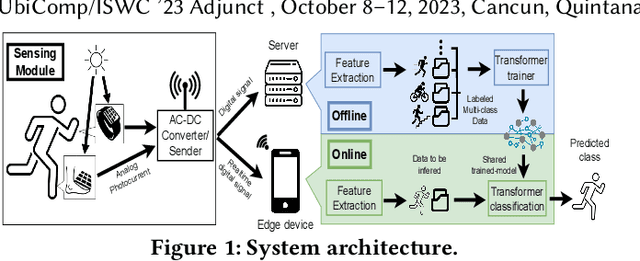
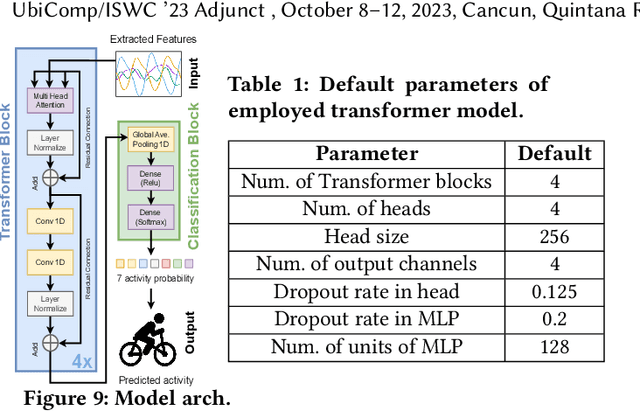
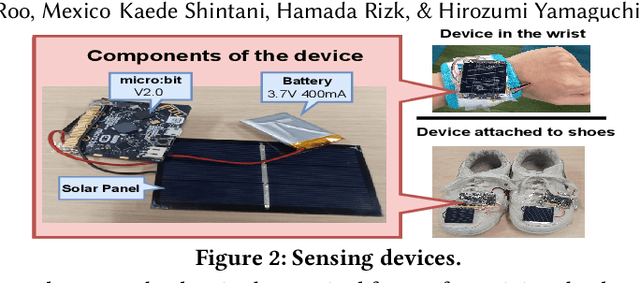
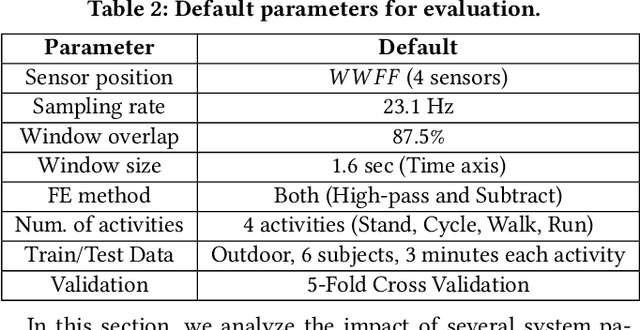
Abstract:With the increasing number of IoT devices, there is a growing demand for energy-free sensors. Human activity recognition holds immense value in numerous daily healthcare applications. However, the majority of current sensing modalities consume energy, thus limiting their sustainable adoption. In this paper, we present a novel activity recognition system that not only operates without requiring energy for sensing but also harvests energy. Our proposed system utilizes photovoltaic cells, attached to the wrist and shoes, as eco-friendly sensing devices for activity recognition. By capturing photovoltaic readings and employing a deep transformer model with powerful learning capabilities, the system effectively recognizes user activities. To ensure robust performance across various subjects, time periods, and lighting conditions, the system incorporates feature extraction and different processing modules. The evaluation of the proposed system on realistic indoor and outdoor environments demonstrated its ability to recognize activities with an accuracy of 91.7%.
Privacy-Preserving by Design: Indoor Positioning System Using Wi-Fi Passive TDOA
Jun 03, 2023Abstract:Indoor localization systems have become increasingly important in a wide range of applications, including industry, security, logistics, and emergency services. However, the growing demand for accurate localization has heightened concerns over privacy, as many localization systems rely on active signals that can be misused by an adversary to track users' movements or manipulate their measurements. This paper presents PassiFi, a novel passive Wi-Fi time-based indoor localization system that effectively balances accuracy and privacy. PassiFi uses a passive WiFi Time Difference of Arrival (TDoA) approach that ensures users' privacy and safeguards the integrity of their measurement data while still achieving high accuracy. The system adopts a fingerprinting approach to address multi-path and non-line-of-sight problems and utilizes deep neural networks to learn the complex relationship between TDoA and location. Evaluation in a real-world testbed demonstrates PassiFi's exceptional performance, surpassing traditional multilateration by 128%, achieving sub-meter accuracy on par with state-of-the-art active measurement systems, all while preserving privacy.
Privacy-Preserving Taxi-Demand Prediction Using Federated Learning
May 21, 2023Abstract:Taxi-demand prediction is an important application of machine learning that enables taxi-providing facilities to optimize their operations and city planners to improve transportation infrastructure and services. However, the use of sensitive data in these systems raises concerns about privacy and security. In this paper, we propose the use of federated learning for taxi-demand prediction that allows multiple parties to train a machine learning model on their own data while keeping the data private and secure. This can enable organizations to build models on data they otherwise would not be able to access. Evaluation with real-world data collected from 16 taxi service providers in Japan over a period of six months showed that the proposed system can predict the demand level accurately within 1\% error compared to a single model trained with integrated data.
Privacy-preserving Pedestrian Tracking using Distributed 3D LiDARs
Mar 22, 2023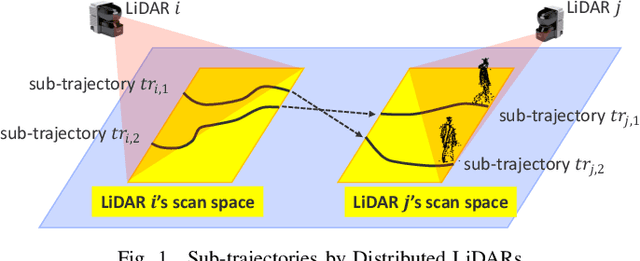
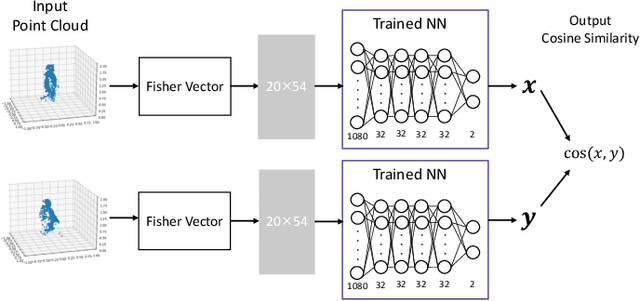


Abstract:The growing demand for intelligent environments unleashes an extraordinary cycle of privacy-aware applications that makes individuals' life more comfortable and safe. Examples of these applications include pedestrian tracking systems in large areas. Although the ubiquity of camera-based systems, they are not a preferable solution due to the vulnerability of leaking the privacy of pedestrians. In this paper, we introduce a novel privacy-preserving system for pedestrian tracking in smart environments using multiple distributed LiDARs of non-overlapping views. The system is designed to leverage LiDAR devices to track pedestrians in partially covered areas due to practical constraints, e.g., occlusion or cost. Therefore, the system uses the point cloud captured by different LiDARs to extract discriminative features that are used to train a metric learning model for pedestrian matching purposes. To boost the system's robustness, we leverage a probabilistic approach to model and adapt the dynamic mobility patterns of individuals and thus connect their sub-trajectories. We deployed the system in a large-scale testbed with 70 colorless LiDARs and conducted three different experiments. The evaluation result at the entrance hall confirms the system's ability to accurately track the pedestrians with a 0.98 F-measure even with zero-covered areas. This result highlights the promise of the proposed system as the next generation of privacy-preserving tracking means in smart environments.
Multi-task Learning for Concurrent Prediction of Thermal Comfort, Sensation, and Preference
Apr 26, 2022


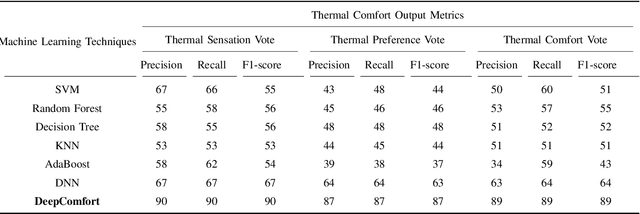
Abstract:Indoor thermal comfort immensely impacts the health and performance of occupants. Therefore, researchers and engineers have proposed numerous computational models to estimate thermal comfort (TC). Given the impetus toward energy efficiency, the current focus is on data-driven TC prediction solutions that leverage state-of-the-art machine learning (ML) algorithms. However, an indoor occupant's perception of indoor thermal comfort (TC) is subjective and multi-dimensional. Different aspects of TC are represented by various standard metrics/scales viz., thermal sensation (TSV), thermal comfort (TCV), and thermal preference (TPV). The current ML-based TC prediction solutions adopt the Single-task Learning approach, i.e., one prediction model per metric. Consequently, solutions often focus on only one TC metric. Moreover, when several metrics are considered, multiple TC models for a single indoor space lead to conflicting predictions, making real-world deployment infeasible. This work addresses these problems. With the vision toward energy conservation and real-world application, naturally ventilated primary school classrooms are considered. First, month-long field experiments are conducted in 5 schools and 14 classrooms, including 512 unique student participants. Further, "DeepComfort," a Multi-task Learning inspired deep-learning model is proposed. DeepComfort predicts multiple TC output metrics viz., TSV, TPV, and TCV, simultaneously, through a single model. It demonstrates high F1-scores, Accuracy (>90%), and generalization capability when validated on the ASHRAE-II database and the dataset created in this study. DeepComfort is also shown to outperform 6 popular metric-specific single-task machine learning algorithms. To the best of our knowledge, this work is the first application of Multi-task Learning to thermal comfort prediction in classrooms.
 Add to Chrome
Add to Chrome Add to Firefox
Add to Firefox Add to Edge
Add to Edge